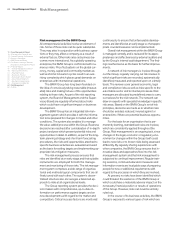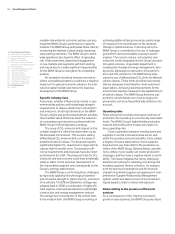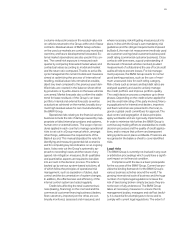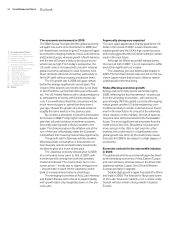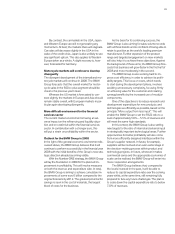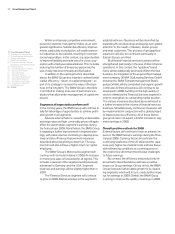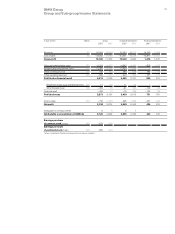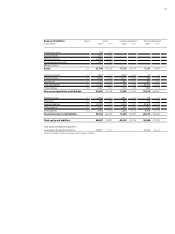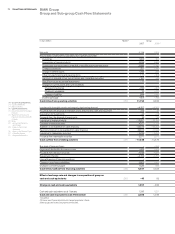BMW 2007 Annual Report Download - page 70
Download and view the complete annual report
Please find page 70 of the 2007 BMW annual report below. You can navigate through the pages in the report by either clicking on the pages listed below, or by using the keyword search tool below to find specific information within the annual report.68 Group Management Report
10 Group Management Report
10 A Review of the Financial Year
13 General Economic Environment
17 Review of Operations
41 BMW Stock and Bonds
44 Disclosures relating to Takeover
Regulations and Explanatory Report
47 Financial Analysis
47 – Internal Management System
49 – Earnings Performance
51 – Financial Position
52 – Net Assets Position
55 – Subsequent Events Report
55 – Value Added Statement
57 – Key Performance Figures
58 – Comments on BMW AG
62 Risk Management
68 Outlook
The economic environment in 2008
The BMW Group forecasts that the global economy
will again lose some of its momentum in 2008, but
will nevertheless continue to grow. The pace will again
be set by the emerging markets in Asia, Latin America
and Eastern Europe, whereas growth in North America
and the rest of Europe is likely to be robust, but no-
where near as high. From today’s perspective, the
US credit crisis is not expected to result in massive
global economic upheaval. It could, however, hold
down domestic demand somewhat, particularly in
the USA itself, without causing a recession there.
The US growth rate in 2008 will again remain
below the average registered in recent years. The
impact of the property and credit crisis is not likely
to tail off until the second half of the year at the earli-
est. The US Federal Reserve will no doubt endeavour
to stimulate the economy with further interest rate
cuts. It is nevertheless likely that consumers will be
much more reluctant to spend than they were a
year ago. Overall, the growth rate should remain at
roughly the same level as in the previous year.
By contrast, a slowdown in growth is forecasted
for Europe in 2008. Firstly, higher interest rates will
take their toll and hold down investment volumes.
Secondly, export growth is likely to weaken once
again. The sharp increase in the inflation rate at the
turn of the year will probably deter the European
Central Bank from lowering interest rates significantly.
The growth rate for Germany will also weaken.
Whereas private consumption is forecasted to re-
main buoyant, exports and particularly investments
are likely to grow at a much slower pace.
The Japanese economy should grow in 2008
at a somewhat lower pace to that of 2007, with
momentum still coming from both the domestic
market and abroad. The recent sharp rise in con-
sumer prices – mostly due to higher energy prices
– should make it easier for the Japanese central
bank to increase interest rates in small steps.
The emerging economies of Asia, Latin America
and Eastern Europe will continue to expand rapidly
with growth rates only marginally down on the pre-
vious year.
A generally strong euro expected
The euro again appreciated sharply against the US
dollar in the course of 2007. Lower interest rates,
weaker growth and the USA’s high current account
deficit all suggest that the US dollar is likely to remain
weak in the near future.
Although the British pound fell steeply during
the second half of 2007, it is not expected to suffer
any further significant loss in value.
The Japanese yen also depreciated sharply in
2007. The fact that interest rates are still on the low
side in Japan means that the yen is likely to remain
undervalued for the time being.
Risks affecting economic growth
Energy and commodity prices will remain high in
2008, reflecting the fact that demand – in particular
from the emerging economies – will continue to
grow strongly. With the global economy still enjoying
robust growth and the US dollar weakening, com-
modities are likely to remain in demand as an invest-
ment in the near future. As a result of the extremely
tense situation on the markets, the risk of specula-
tive price rises remains present for the foreseeable
future. The most significant risk emanates from the
credit crisis in the USA. Should the crisis become
more serious in the USA or spill over into other
markets, this could result in a significantly lower
global growth rate. All in all, the credit crisis causes
forecasts for 2008 to be subject to a high degree of
uncertainty.
Economic outlook for the automobile industry
in 2008
The global automotive economy will again be driven
by the emerging economies of Asia, Eastern Europe
and Latin America, whereas sales on the three main
traditional markets (Japan, the USA and Western
Europe) are likely to stagnate.
Double-digit growth is again forecasted for China
and India in 2008. The forecast for Russia and some
of the Latin American markets is on a similar scale.
Growth will also remain strong overall in Eastern
Europe.
Outlook






